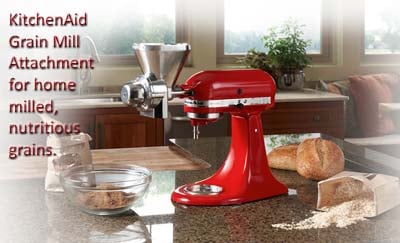A Facebook follower had asked me which grain mill was the best. I had not used one before, but it was on my wish list of kitchen must-haves. She brought up the KitchenAid Grain Mill Attachment. KitchenAid was very generous in sending me one to review. I believe you’ll find this review very informative, not only on the grain mill itself, but on the nutrition of the gluten-free diet.
Benefits of Grinding Your Own Gluten Free Grains
When on a gluten free diet, we lack the fiber and nutrition that gluten grains provide. If you’re baking with healthy whole grain gluten free flour, you can still benefit from milling your own grains at home. Allow me to explain.
[showmyads]
The commercial flour we purchase is processed more than you realize. The bran and germ of the grains are removed. This step is necessary to extend shelf life. Once bran and germ is ground it only lasts for about three days before it goes rancid as it contains oil.
 Those natural oils and vitamins from freshly ground grains benefit our health greatly. You grind the grains as you need them.
Those natural oils and vitamins from freshly ground grains benefit our health greatly. You grind the grains as you need them.
Benefits of Coarse Grain Textures
The KitchenAid Grain Mill Attachment mills the grains as fine as the commercially milled flour you use now or as coarse as you can imagine. The coarser the texture, the more fiber in your gluten free diet, which is very important since the diet lacks fiber. You are probably consuming high amounts of starch. What better way to balance out those carbs than with coarsely fresh milled grains?
Texture to Use in Gluten Free Yeast-Free Bread
Many of you have requested that I develop a recipe for a yeast-free gluten-free bread. While I have not yet perfected the recipe, I find that roughly milled grains provide the closest texture to yeast bread than any other flour. Without them, all you are really using are cake ingredients. Rather than a loaf of bread being full of starch, the coarse grains provide a whole grain texture. The bread is heartier and and full of flavor.
Grains You Can Mill
KitchenAid suggests to mill low-moisture, non-oily grains such as wheat, corn, rye, oats, rice, buckwheat, barley, and millet. While you will not be milling wheat, barley or rye, I have found that it does grain armaranth. Amaranth seeds are so small that this is no easy task. It does not grain them as fine as it does grains, it is sufficient enough to bake with.
Examples of Fine Texture and Flour to Starch Ratios
Below I provide you with photos of grains I milled in my own Kitchen using the KitchenAid Grain Mill attachment to give you examples of how fine a texture you may achieve. When compared to the commercial flour you now purchase, it either mills them finer, in the case of oats, or a bit less fine, in the case of brown rice. However, when milling millet it is equal to commercial millet flour. All of these results are incredible, as the bran and germ are also milled, usually creating a coarser texture.
Tip: When removing the knob that adjusts for texture fineness you can tighten the screw underneath to create a finer texture. The owner’s manual does not mention this, however, my husband tried it, and improved the fine texture by about 10 times. Just be careful, though. You do not want to put a strain on your machine. The owner’s manual suggests to only mill up to 10 cups of grains and then give your machine a rest for 45 minutes. When I mill them fine with the screw tightened, I allow it to rest for about 15 minutes after about 1 – 2 cups.
Oats: Though the oats must be hulled before grinding, rolled gluten free oats may be used. Oats may be used in gluten free recipes up to 60% to 40% starch ratio.

Millet: Though KitchenAid suggests toasting millet in a dry skillet prior to milling, I skipped this step in the photo below. Millet flour also may be used in a 40% to 60% starch ratio.

Rice: Both white and brown rice may be ground in the KitchenAid Grain Mill. Rice flour may be used in a 50% to starch in gluten free recipes.


Corn: I find that a medium textured flour works well in cornbread, though you may use the typical corn meal texture. The medium grain provides more heartiness and texutre to cornbread. Corn meal may be used in a 50% meal to starch ratio.
Buckwheat: Buckwheat, too, should be hulled before milling. You may also toast buckwheat for grinding, or you may grind it in its raw form. Buckwheat may be used in a 40% to 60% starch ratio in your gluten free recipes.
I am thrilled with my new KitchenAid Grain Mill Attachment! It fits all KitchenAid stand mixers. Visit the KitchenAid website to view additional details or to purchase a Grain Mill Attachment. You may also view the product manual at http://www.kitchenaid.com/assets/pdfs/product/ZUSECARE/P05050136.pdf.
Tip: Store your freshly ground grains in the freezer to prevent rancidity. When left at room temperature, they will not last more than 3 days. The natural oils cause them to go rancid quickly, and there are not preservatives in these flours.



